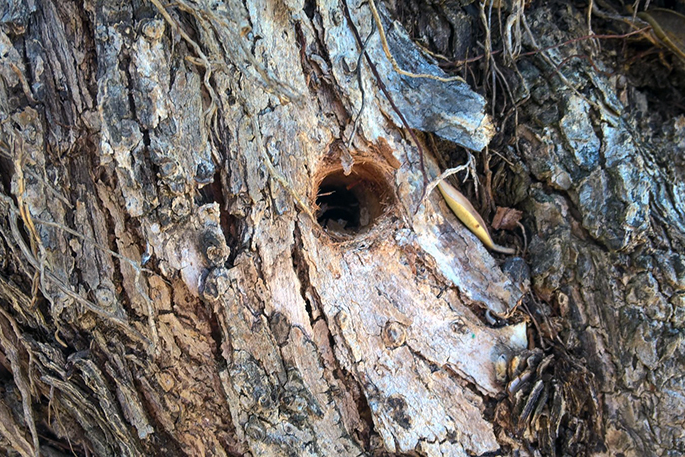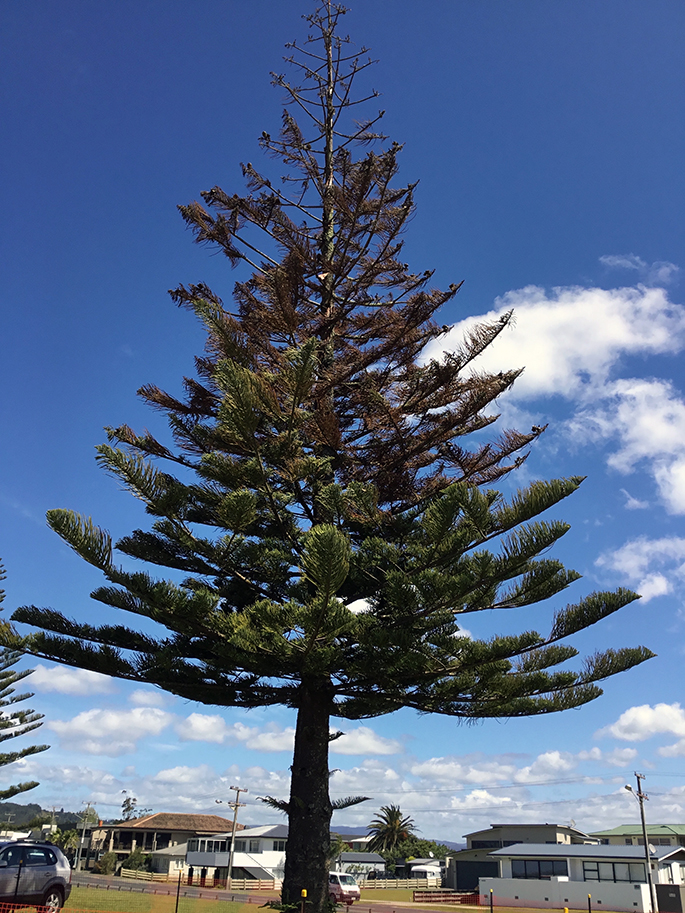The Thames-Coromandel District Council is disappointed and disturbed by a spike in the number of trees on council land being poisoned or vandalised.
Since Labour Weekend there have been a large number cases of trees across the district being damaged or destroyed on a regular basis, says Parks and Reserves manager Derek Thompson.
A recent incident saw two trees being damaged at Moore Crescent Reserve at Opito Bay.
'One of the trees was of particular significance to the area as it provided shade and our contractors were completing on-going crown-lifting and pruning work on the tree.
'The work being done was to preserve it in a way that also created a nice shape of the tree so it could frame the near-by property views, rather than blocking the views.
'What has been done here is totally not acceptable and is a real concern of what is happening in our region.”

One of the trees damaged in Opito Bay. Photo: TCDC
He explains there were stages of development the tree needed to go through to achieve the desired outcome and the tree was almost at this stage.
Unfortunately somebody thought it was ok to cut back the trees, laments Derek.
'However, this increases secondary growth and means the tree is likely to grow back worse, or thicker, and will now take years to get back to a stage where it can be developed again.”
Several residents in Opito Bay have informed council's parks contractors they are also upset by the destruction of their trees.
'Often people will discuss their intentions or actions to remove a tree from their view and it is important that people are aware of the steps to take and options available.”

An example of the damage cause to one of the trees at Opito Bay. Photo: TCDC
Another recent case of tree poisoning reported to the council involves one of the Norfolk Pines on Buffalo Beach, Whitianga. The tree has since been cordoned off, with a local tree expert confirming it has been poisoned and there's now the threat of falling branches and pine cones.
The Mercury Community Board is disappointed and saddened to see a tree of this prominence and age, said to be between 70–80 years old, has been intentionally destroyed.
Other areas where incidents have occurred includes Pauanui where a whole cul-de-sac of trees has been killed and in Tairua every year trees are damaged on the front of the estuary.
Previous cases of tree destruction have resulted in court action and complaints being laid with police.
'Our district has beautiful native coastal trees on public reserves and are there for the enjoyment of everybody,” says TCDC Whangamata area manager Gary Towler.
'We take this type of vandalism very seriously due to the on-going incidences including Williamson Park, Island View Reserve, The Esplanade, Onemana and the beach reserve at the end of Tuck Road.”
Garry is encouraging everyone who sees any suspicious activity or people intentionally damaging trees to 'say something”.
'If there are any issues with a tree, visit your local area office and discuss it, as in many cases there may be professional tree management options.”
OPTIONS FOR TREES ON THAMES-COROMANDEL DISTRICT COUNCIL LAND:
Depending on the tree, species, location and age there are a few things which can be done, says the Thames-Coromandel District Council.
- Deadwooding: Most trees are self-pruning and dead wood will drop from the trees, but this does not happen all at once, so by removing wood that is dead, we can improve the health of the tree, let more light through the canopy and possibly improve views.
- Crown thinning: This is like deadwooding, but also includes the removal of live wood as well. This may include the removal of branches that have not formed well, may be rubbing against each other, or may be inherently weak. The benefits or the side effects can be similar to deadwooding.
- Crown lifting: This is where the canopy is trimmed to lift it higher. This can be done for many reasons, including public safety; for example, if a tree has branches over a footpath at head height there's a risk of injury.
- Power lines clearance: This is generally escalated to Powerco's contractors who need to undertake the work due to the hazardous nature of working near live power cables.
If the tree is dead or believed to be threatening life, property or essential services a council officer will visit the site.
The advice of an independent arborist may be sought if the officer believes there is no threat or if there may be objections from other parties to council action about the tree.
For more information, to talk to someone about a tree in your neighbourhood or to launch a request for service call the Thames-Coromandel District Council customer service team on 07-868-0200, email customer.services@tcdc.govt.nz or visit: www.tcdc.govt.nz/rfs

The poisoned Norfolk Pine at Buffalo Beach, Whitianga. Photo: TCDC



1 comment
Norfork pines
Posted on 18-11-2016 20:27 | By Capt_Kaveman
are so ugly i wish they would remove them all, people who poison natives need to be locked up, + wats with people who think tropical palms etc a nice when i think they ugly and dont suit the the landscape, govt need to restrict this in invasion even on private property
Leave a Comment
You must be logged in to make a comment.